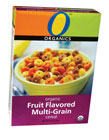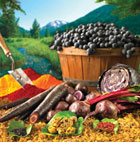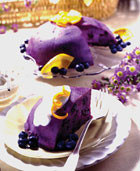It could even be said that when a product is widely successful, color seldom is credited for the success. Rarely is a product's coloring consciously noticed by consumers, unless a product is uncommonly or incorrectly colored.

Receiving Looks
People use the color of food to make many different decisions. It may help to evaluate the ripeness of fruits and vegetables, caution against eating unsafe foods, assess the temperature and degree of doneness or help distinguish variations and flavors for connoisseurs.Although there are some central food color themes that are accepted around the world, preference and acceptance of food product coloring can be subjective and dependent upon what the specific consumer has been conditioned to expect. Even within regions and cultures, color interpretations may differ from person to person, as color evokes emotions that may be based on their individual history. For example, although they were added again in 1995, some people will always remember that red M&Ms were removed from the traditional M&M color mix due to public controversy surrounding a particular red food coloring. Even though the coloring was not actually used in M&Ms, the company removed red M&Ms to avoid consumer confusion.
Color Interactions
Colorants rarely are used alone; they usually are used with a combination of other ingredients. Additionally, color can be negatively affected when a product is exposed to heat or light, either during processing, in storage or at the retail sector.Manufacturers use sensory tests because they need to know how normal heat processing, gloss from glazes, water activity, opacity and texture affect color and appearance. Instrumentation is used to determine how these factors impact color, but visual sensory tests can measure a consumer's preference for a food.
Furthermore, the popularity of nutraceuticals and functional foods has encouraged an increase in food fortification and enrichment. These are additions that can affect a product's color and also shape the acceptance of that product by loyal or new customers. Sensory testing for preference may alert formulators up front that the new colors, although harmless to taste or well being, might be distasteful to consumers.

Caramel Color Challenges
Caramel color is the dark brown material that results from the carefully controlled heat treatment of food grade carbohydrates. When trying to determine which of the four caramel colors will work best in certain applications, it is important to test tinctorial power (a measure of color strength), pH and Baume (a measure of liquid density or solids level).Adding a caramel color with the wrong ionic charge can cause color precipitation, flocculation or migration problems. “Class III caramels have a positive charge, and Class II caramels have a strong negative charge,” says Terry Geerts, application chemist at a caramel color company. “It is possible to blend Class I, II or IV and not have an ionic haze or precipitation.”
According to Geerts, when caramel colors are being used to match the appearance of another product, it is also necessary to examine taste and odor. Unlike some FD&C dyes, caramel colors also affect flavor. The ammonia in Class III produces more flavor components, which can cause a chocolate or coffee-like flavor. On the other hand, Class IV is mild and typically used as a cola caramel.
Many processors are interested in Class I caramels because they are considered to be more natural compared to the other caramel classes. “However, they have low color strength, and manufacturers tend to use more of them to increase the color strength,” says Geerts. Unfortunately, Class I also has a strong bitter aftertaste, which can be doubled during an attempt to increase color strength. “Certain caramel coloring companies offer a Class I caramel that does not have a strong bitter aftertaste,” notes one supplier.
Caramel is the most widely used colorant. It is especially popular in the beverage industry, but caramel colors also are prevalent in baked goods, meat products and texturized vegetable proteins. Caramel colors can be used to imitate special processes, such as the addition of grill marks, which may provide an added value to some consumers. For instance, the front of the package of Boca Meatless Grilled Vegetable Soy Protein Burgers shows that the burgers within the packaging have grill marks. The grill marks may have not been created on a grill, but with the use of caramel color, which is listed on the ingredient legend.
Color Testing
Visual appraisal and instrumental color analysis are the only two choices for food color evaluation. Whether to use one over the other depends on the manufacturer's intention. If he is more interested in pursuing trends in consumer preference, he may choose visual appraisal. If tracking color changes for quality assurance is his goal, then he would choose instrumental color analysis.At the 2003 annual IFT convention, researchers at the Department of Animal Sciences & Industry at Kansas State University offered that when selecting visual evaluations, sensory scientists can choose either a consumer panel or a trained descriptive panel. However, the presenters cautioned that consumer panels are less suitable for accurately describing color; rather they are ideal for predicting consumer preference using hedonic scales.
A typical hedonic scale will require participants to choose between a range of qualifiers beginning with “like very much” and ending with “dislike very much.” Others can be more creative. For example, when working with children, trained sensory scientists use scales with varying degrees of facial expressions (ranging from a happy face to a frown) to identify a child's preference for a food color. “To be useful, a color scale should relate to how we see color, be simple to understand, be linear throughout color space and be able to quantify color differences,” writes Hal Good, director of marketing services at HunterLab, a manufacturer of colorimetric instrumentation.
“Visual color assessment can be done; however, it has several shortcomings,” states Good. “First, to make reliable visual evaluations, multiple variables must be controlled.”
The following visual assessment variables include:
* The spectral quality, intensity and angular size of the light source.
* The direction from which the light strikes the sample.
* The direction in which the sample is viewed.
* The distance between the specimen and color standard.
* The observer's spectral response.

Good also notes that color variation and moisture content can be related. Manufacturing processes such as extrusion and baking can affect final product color. “Thus, to obtain and maintain the desired color, it is important to monitor and control ingredient color as well as monitor the product through the manufacturing process,” informs Good.
The monochromatic colorimeter, tristimulus colorimeter and colorimetric spectrophotometer are three instruments that are widely used in the food industry to measure fresh and processed fruits and vegetables, as well as formulated or compounded foods. According to HunterLab, when examining or measuring an object for color and appearance, it is important to categorize it as an opaque nonmetal, opaque metal (rarely a food), transparent material or translucent material. The category of an object gives important clues about how it should be measured and which instrument to use.
Good informs that opaque nonmetals do not allow any light to pass through them. Transparent materials allow much of the light from the light source to pass through. Translucent materials also can be solid or liquid. Translucent objects are not easy to measure, since any variations in their thickness or background will affect their color.
Chromatic attributes are those attributes associated with color. They normally are divided into three components: lightness, hue and saturation. Lightness describes whether the color is closer to black or white. Sometimes the term “value” is used rather than lightness. Hue is the perceived color of an object, such as red, green, blue, yellow or orange. Saturation describes the vividness or purity of a color. For example, bright candy apple red is more saturated than dull brick red. It can also be defined as the degree of departure from gray.
Color Correctness
A trend that can be read across many color articles is that perceived taste and/or flavor intensity increases as the color level increases. In a 1993 article published in Critical Reviews in Food Science and Nutrition, Fergus M. Clydesdale argues that this color effect seems to result from learned associations rather than from inherent psychophysical characteristics. Food science research performed by Cynthia N. DuBose, et al., and published in the Journal of Food Science, suggests that novel food colors have potential as an attention-getting and brand differentiating communications tool.Flavor information typically comes to the consumer in three forms. When first encountered in the store, the label and packaging build expectations about flavor. Preparation of the food is second, and it ends with the actual consumption of the food. A consumer's first reaction to a product's coloring at the point of purchase will carry down through all interactions with the product.
In a paper entitled “Color Measurement of Cereal and Cereal Products,” Good reports that color and flavor are often directly related. “For instance, a breakfast cereal that looks dark may taste burnt; if it looks light, it will probably taste underdone.”
In the article “The Impact of Perceptual Interactions on Perceived Flavor,” Jeannine Delwiche, the head of the Ohio State University Sensory Science Group, writes, “Several studies have shown that color greatly impacts the ability of subjects to identify food and beverages. In such studies, uncolored and mis-colored items are routinely identified correctly less frequently than appropriately colored items.” Delwiche also points to other studies that suggest that odors are also less likely to be identified when they are presented to consumer panels without color cues or when paired with inappropriate colors.

Color and Palatability
Color associations not only might impact a consumer's ability to distinguish between flavors, it can also affect palatability. In “The Effects of Food Color on Perceived Flavor,” author Lawrence L. Garber, Jr., an associate professor of marketing at Appalachian State University, writes, “Food producers commonly select, modify, heighten or standardize the colors that we see and come to associate with specific foods. Green for peppermint or brown for cola are examples. The effects of conditioned food color/flavor associations in color-associated foods becomes so ingrained that the unexpected pairing of a given food with a novel color renders it unpalatable.”Other studies from Delwiche and her colleagues support the idea that “individuals associate certain flavors (and odors) with specific colors and, when the colors are altered, the flavor/odor identification is decreased: the stronger the color-flavor/odor association, the greater the impact of color.” Research conducted in 1990 by Debra A. Zellner and Mary A. Kautz and published in the Journal of Experimental Psychology: Human Perception & Performance, found that “Solutions were rated as having more intense odors with color cues than without, regardless of color-odor appropriateness.” Additionally, color-taste associations reveal that color changes can also impact the degree of sweetness. On the other hand, Zellner and Kautz also theorized that although color can alter perceived taste, smell and flavor ratings, the elimination of visual input with a blindfold does not significantly alter flavor from that of a colorless solution.
Ignoring the influence of color on consumer acceptance and preference is akin to taking for granted the texture or flavor. Sensory testing can provide quantitative and qualitative safeguards to prevent a product from being colored in the wrong light.
Website Resources:
www.hunterlab.com -- Information about color measurement instrumentswww.sethness.com -- Site with information on the four classes of caramel coloring
http://ssg.fst.ohio-state.edu/ -- The sensory science group at Ohio State University
Showcase: Sensory Services and Coloring Components

Black Malt Extract is an all-natural colorant from Briess Malt & Ingredients Company. Made from the same malt that gives stout beers their color, it is available as both liquid (Maltoferm® A-6000) and dry (Maltoferm® A-6001), and provides brown to black color. Applications include meat, meat analog products, sauces, gravies and dark baked goods. Its color intensity is about half as strong as traditional caramel colors. It is pH-stable, light-stable and has a shelflife of more than two years and is available as organic. Bernadette Wasdovitch, info@briess.com, www.briess.com
Product Dynamics' Quant Quali Optimization™ blends quantitative data and qualitative insight together to drive fast-paced product development. A reiterative process of quantitative consumer assessment combines with the understanding of consumer opinions, perceptions and emotions derived from qualitative discussions to direct product modification and feed the next quantitative assessment—all in the matter of days, not weeks. Your product develops in real time, molded by consumer reaction and confirmed by quantitative data. Product Dynamics, a division of RQA Inc., Judy Lindsey, 708-364-7060, ext. 141, j.lindsey@rqa-inc.com

Sethness caramel color can be used to achieve food colors from light yellows to deep browns. Available in both liquid and spray-dried powder specifications, this highly stable product offers application flexibility, versatility and economy. The line includes GMO-free caramel colors and a new certified organic liquid caramel color. Used in virtually every segment of the food industry, Sethness caramel color applications include beverages, baked goods, sauces, soups, cereals, dry mixes and pet foods. Sethness Products Company, 888-772-1880, mail@sethness.com, www.sethness.com

